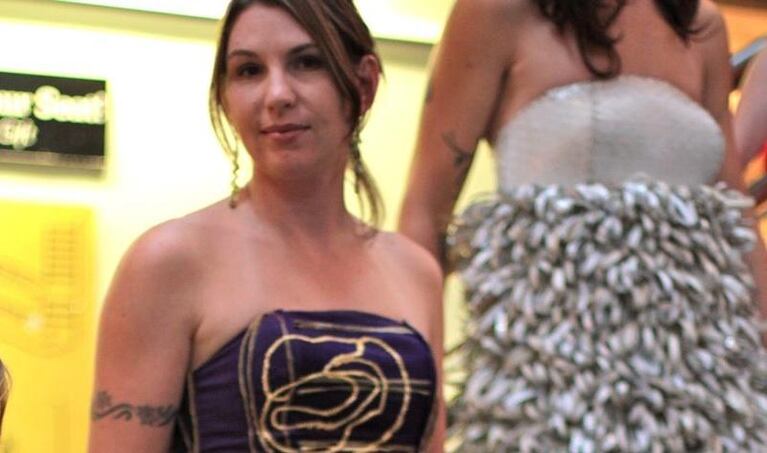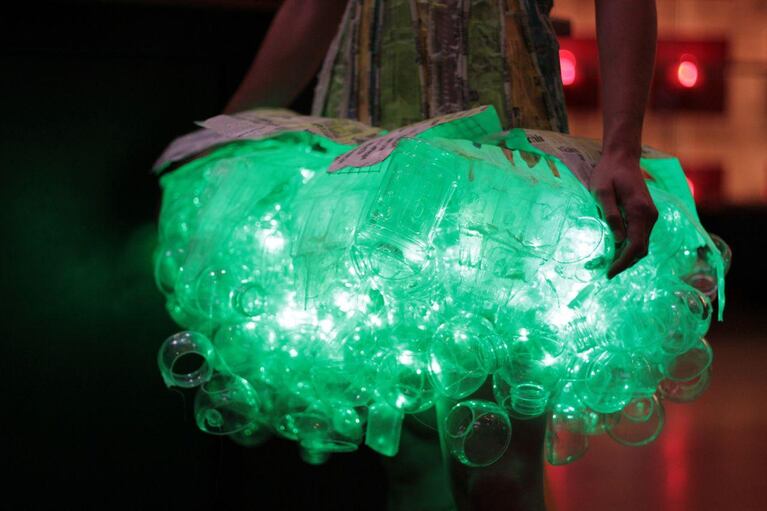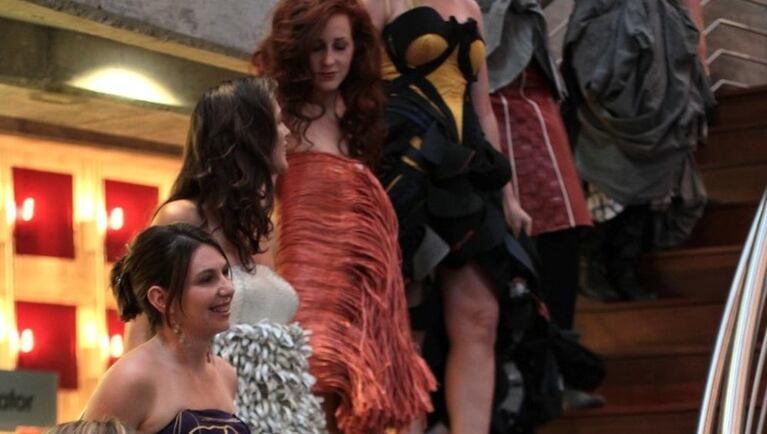
Shaunna Sutcliffe is looking regal draped in more than 500 Crown Royal whiskey bags stitched into a floor-length ball gown.
Ifanyi Bell
PORTLAND -- Why send trash to the landfill when it could go into your next outfit instead?
That's the message Portland-based nonprofit Junk to Funk is spreading around the Northwest with eye-popping runway designs made out of garbage.
Old mini-blinds? Oh-so sexy. Plastic grocery bags? You can wear them to the beach. And don't throw out those purple felt Crown Royal sacks; They're floor-length gown material!
Junk to Funk made a name for itself from 2006-09 with elaborate fashion shows in Portland. The idea was to encourage people to stop thinking of their garbage as waste and start thinking about how it can be put to other uses. The fashion show moved off-stage last year and into some new programs that spread the word through schools and businesses.
OPB Arts & Life on Junk to Funk
This is the way Ecotrope blogger Cassandra Profita reported on the Junk to Funk Collective's latest show. To see OPB Arts & Life Producer Ifanyi Bell's take on the same event, click here.
Last week, when the group trotted out some of its best runway styles at Portland’s Go Green '11 sustainable business conference, there was also a new item in the mix: A dress made out of Vitamin Water bottles featuring a giant, glowing bubble skirt and multicolored corset that was commissioned by Vitamin Water itself.
To sustain the financial side of the Junk to Funk Trashion Collective, Director Lindsey Newkirk is planning to do more work with businesses that want to hold their own Junk to Funk-style events or see their own waste streams turned into fashion.
She also wants to take the idea to summer camps and school programs to teach students how it's done.
The Junk to Funk designs underscore the potential to go beyond curbside recycling, Newkirk says, and into a new way of thinking about our so-called waste.
Overall, Northwest recycling rates are on the rise. Here's a snapshot:
Oregon
Statewide recycling reached 50 percent of total waste generation in 2010 – up 1.7 percent from 2009, according to this announcement last week from Oregon Department of Environmental Quality. Mary Lou Perry at DEQ said recycling trends are moving in the right direction.
“The size of Oregon’s whole waste pile remained nearly constant, but recovery of materials rose while disposal fell,” she said. Perry said using biomass to generate energy could help divert more waste from landfills in the coming years, as will an increase in the amount of food waste getting composted through curbside composting programs.
DEQ estimates recycling in Oregon last year created energy saving equal to 258 million gallons of gasoline – or roughly 3 percent of total energy used by all sectors of the state’s economy. It also reduced greenhouse gas emissions equivalent to the tailpipe emissions from 620,000 passenger cars, or roughly 4.3 percent of all greenhouse gas emissions in the state during 2010.
Idaho
Ben Jarvis of the Idaho Department of Environmental Quality said there’s no statewide mandate for recycling in Idaho. And in counties that don’t have the economies of scale to make it affordable, there may be no recycling services. That said, there are two rural regions that just started recycling programs, including Idaho County. And more densely populated areas of the state are seeing their recycling rates skyrocket as comingled, or no-sort recycling, collection programs start up.
Boise is among the cities leading the charge toward commingled curbside recycling, where you can throw all the recyclables into one collection bin. The program has helped Boise to increase its recycling rate to 25 percent from 13 percent in 2009.
Washington
Every county in Washington state has some kind of recycling availability, according to Gretchen Newman of the state Department of Ecology's Waste 2 Resources Program. If there's no curbside collection, there is a drop-off site. And each county is supposed to have a recycling plan for how to divert more waste from landfills.
The city of Seattle announced earlier this year that its recycling rate hit 53.7 percent in 2010. Individual families in the city are recycling a whopping 70.3 percent of their waste. Meanwhile, the state as a whole diverted 47 percent of its waste from landfills in 2009. And according to Newman, the state is putting new programs in place that will make the manufacturers of electronic devices responsible for what happens to their products at the end of their life.




